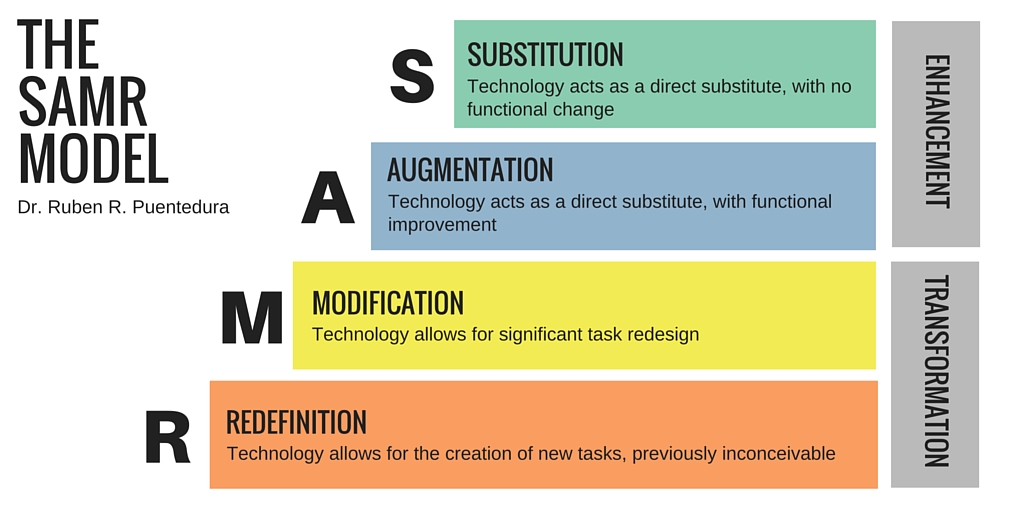This week was a really great recap. I feel like because we haven’t had a ‘normal’ class in two weeks, a semester recap was much needed. Next, we covered the topic of technology integration!

Here we were introduced to the Substitution, Augmentation, Modification, or Redefinition Model. This model analyzes the impact of technology on both teaching and learning. SAMR can be a guide for teachers to assess how they are integrating technology in learning. Here teachers can ask themselves if the technology they are using in the classroom allows for enhanced learning or transformative learning. Here we discussed what ‘teaching above the line’ can look like, which essentially means how we, as educators, use media to transform our student’s learning experiences? Below I’ll break down some examples of how this can be used in the classroom.
ENHANCEMENT:
Substitution: Typing vs writing a paragraph response. In this example, we are dealing with the same assignment but one uses technology.
Augmentation: Like substitution, tech acts as a tool that substitutes. Only this time around, this substitution has a functional improvement. Google Docs for example allows students to work on formatting and spell-check. Something they didn’t have access to before with pen and paper.
TRANSFORMATION:
Modification: This is a complete redesign! In this new realm, it opens up different ways to approach assessment (e.x. collaboration and personal expression). Students can connect online and work collaboratively on assignments whether it’s peer editing or even group work via google docs and Word.
Redefinition: Here, tech allows for the creation of a new task. This is a great zone of focus as a future educator because it means we don’t have to continuously repeat the same assignment. Here we can re-conceive the same base idea.

The other model we focused on today was The technological pedagogical content knowledge (TPACK) model. This combines what teachers know, how they teach, and the role technology plays in impacting teaching. As explained by Schoology, “TPACK is a technology integration framework that identifies three types of knowledge instructors need to combine for successful edtech integration—technological, pedagogical, and content knowledge.” TPACK is a great way for educators to better understand the integrated relationship between pedagogy, content, and technology.
I thought that these models were both really cool concepts because they got me thinking about different ways I can use technology to meet the needs of every student. Technology, as I have learned over the past few weeks, opens up so many possibilities within the classroom! These models are both great ways that I can challenge my own understanding and push myself to find new ways to teach. Breaking this process down by understanding that I can integrate Content Knowledge (CK) (what I know), Pedagogical Knowledge (PK) (how do students learn best), and Technological Knowledge (TK) (what digital tools are available to me) is somewhat simpler than I had imagined in my head. I am excited to use these models in my future lesson planning and teaching. Especially when looking into different elementary grades!
Sources:
Schoology. (n.d.). The TPACK Framework explained (with classroom examples). Schoology. Retrieved March 1, 2022, from https://www.schoology.com/blog/tpack-framework-explained
Photo: https://commons.wikimedia.org/wiki/File:The_SAMR_Model.jpg
Photo: https://www.flickr.com/photos/geographypages/8280963584

Leave a Reply
You must be logged in to post a comment.